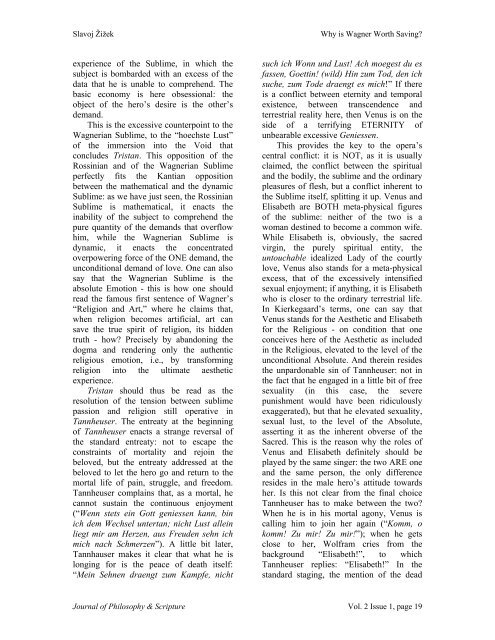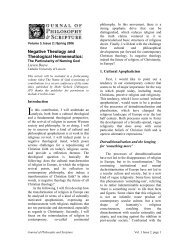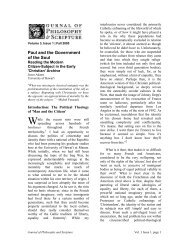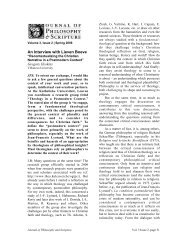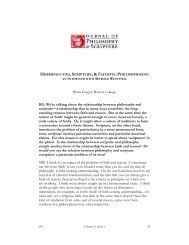Why is Wagner Worth Saving? Slavoj Žižek - Journal of Philosophy ...
Why is Wagner Worth Saving? Slavoj Žižek - Journal of Philosophy ...
Why is Wagner Worth Saving? Slavoj Žižek - Journal of Philosophy ...
You also want an ePaper? Increase the reach of your titles
YUMPU automatically turns print PDFs into web optimized ePapers that Google loves.
<strong>Slavoj</strong> Žižek<br />
<strong>Why</strong> <strong>is</strong> <strong>Wagner</strong> <strong>Worth</strong> <strong>Saving</strong>?<br />
experience <strong>of</strong> the Sublime, in which the<br />
subject <strong>is</strong> bombarded with an excess <strong>of</strong> the<br />
data that he <strong>is</strong> unable to comprehend. The<br />
basic economy <strong>is</strong> here obsessional: the<br />
object <strong>of</strong> the hero’s desire <strong>is</strong> the other’s<br />
demand.<br />
Th<strong>is</strong> <strong>is</strong> the excessive counterpoint to the<br />
<strong>Wagner</strong>ian Sublime, to the “hoechste Lust”<br />
<strong>of</strong> the immersion into the Void that<br />
concludes Tr<strong>is</strong>tan. Th<strong>is</strong> opposition <strong>of</strong> the<br />
Rossinian and <strong>of</strong> the <strong>Wagner</strong>ian Sublime<br />
perfectly fits the Kantian opposition<br />
between the mathematical and the dynamic<br />
Sublime: as we have just seen, the Rossinian<br />
Sublime <strong>is</strong> mathematical, it enacts the<br />
inability <strong>of</strong> the subject to comprehend the<br />
pure quantity <strong>of</strong> the demands that overflow<br />
him, while the <strong>Wagner</strong>ian Sublime <strong>is</strong><br />
dynamic, it enacts the concentrated<br />
overpowering force <strong>of</strong> the ONE demand, the<br />
unconditional demand <strong>of</strong> love. One can also<br />
say that the <strong>Wagner</strong>ian Sublime <strong>is</strong> the<br />
absolute Emotion - th<strong>is</strong> <strong>is</strong> how one should<br />
read the famous first sentence <strong>of</strong> <strong>Wagner</strong>’s<br />
“Religion and Art,” where he claims that,<br />
when religion becomes artificial, art can<br />
save the true spirit <strong>of</strong> religion, its hidden<br />
truth - how? Prec<strong>is</strong>ely by abandoning the<br />
dogma and rendering only the authentic<br />
religious emotion, i.e., by transforming<br />
religion into the ultimate aesthetic<br />
experience.<br />
Tr<strong>is</strong>tan should thus be read as the<br />
resolution <strong>of</strong> the tension between sublime<br />
passion and religion still operative in<br />
Tannheuser. The entreaty at the beginning<br />
<strong>of</strong> Tannheuser enacts a strange reversal <strong>of</strong><br />
the standard entreaty: not to escape the<br />
constraints <strong>of</strong> mortality and rejoin the<br />
beloved, but the entreaty addressed at the<br />
beloved to let the hero go and return to the<br />
mortal life <strong>of</strong> pain, struggle, and freedom.<br />
Tannheuser complains that, as a mortal, he<br />
cannot sustain the continuous enjoyment<br />
(“Wenn stets ein Gott geniessen kann, bin<br />
ich dem Wechsel untertan; nicht Lust allein<br />
liegt mir am Herzen, aus Freuden sehn ich<br />
mich nach Schmerzen”). A little bit later,<br />
Tannhauser makes it clear that what he <strong>is</strong><br />
longing for <strong>is</strong> the peace <strong>of</strong> death itself:<br />
“Mein Sehnen draengt zum Kampfe, nicht<br />
such ich Wonn und Lust! Ach moegest du es<br />
fassen, Goettin! (wild) Hin zum Tod, den ich<br />
suche, zum Tode draengt es mich!” If there<br />
<strong>is</strong> a conflict between eternity and temporal<br />
ex<strong>is</strong>tence, between transcendence and<br />
terrestrial reality here, then Venus <strong>is</strong> on the<br />
side <strong>of</strong> a terrifying ETERNITY <strong>of</strong><br />
unbearable excessive Geniessen.<br />
Th<strong>is</strong> provides the key to the opera’s<br />
central conflict: it <strong>is</strong> NOT, as it <strong>is</strong> usually<br />
claimed, the conflict between the spiritual<br />
and the bodily, the sublime and the ordinary<br />
pleasures <strong>of</strong> flesh, but a conflict inherent to<br />
the Sublime itself, splitting it up. Venus and<br />
El<strong>is</strong>abeth are BOTH meta-physical figures<br />
<strong>of</strong> the sublime: neither <strong>of</strong> the two <strong>is</strong> a<br />
woman destined to become a common wife.<br />
While El<strong>is</strong>abeth <strong>is</strong>, obviously, the sacred<br />
virgin, the purely spiritual entity, the<br />
untouchable idealized Lady <strong>of</strong> the courtly<br />
love, Venus also stands for a meta-physical<br />
excess, that <strong>of</strong> the excessively intensified<br />
sexual enjoyment; if anything, it <strong>is</strong> El<strong>is</strong>abeth<br />
who <strong>is</strong> closer to the ordinary terrestrial life.<br />
In Kierkegaard’s terms, one can say that<br />
Venus stands for the Aesthetic and El<strong>is</strong>abeth<br />
for the Religious - on condition that one<br />
conceives here <strong>of</strong> the Aesthetic as included<br />
in the Religious, elevated to the level <strong>of</strong> the<br />
unconditional Absolute. And therein resides<br />
the unpardonable sin <strong>of</strong> Tannheuser: not in<br />
the fact that he engaged in a little bit <strong>of</strong> free<br />
sexuality (in th<strong>is</strong> case, the severe<br />
pun<strong>is</strong>hment would have been ridiculously<br />
exaggerated), but that he elevated sexuality,<br />
sexual lust, to the level <strong>of</strong> the Absolute,<br />
asserting it as the inherent obverse <strong>of</strong> the<br />
Sacred. Th<strong>is</strong> <strong>is</strong> the reason why the roles <strong>of</strong><br />
Venus and El<strong>is</strong>abeth definitely should be<br />
played by the same singer: the two ARE one<br />
and the same person, the only difference<br />
resides in the male hero’s attitude towards<br />
her. Is th<strong>is</strong> not clear from the final choice<br />
Tannheuser has to make between the two?<br />
When he <strong>is</strong> in h<strong>is</strong> mortal agony, Venus <strong>is</strong><br />
calling him to join her again (“Komm, o<br />
komm! Zu mir! Zu mir!”); when he gets<br />
close to her, Wolfram cries from the<br />
background “El<strong>is</strong>abeth!”, to which<br />
Tannheuser replies: “El<strong>is</strong>abeth!” In the<br />
standard staging, the mention <strong>of</strong> the dead<br />
<strong>Journal</strong> <strong>of</strong> <strong>Philosophy</strong> & Scripture Vol. 2 Issue 1, page 19


